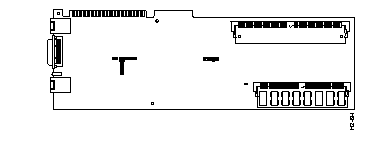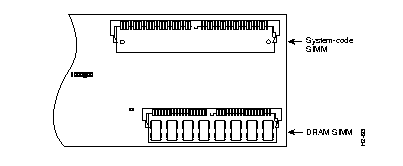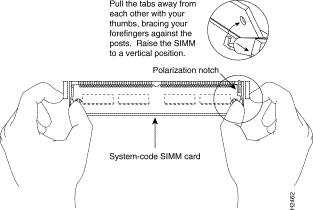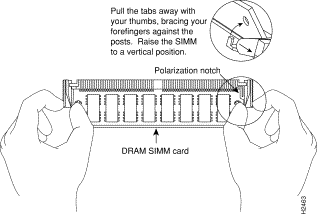|
|

This chapter explains how to maintain the AccessPro PC card and contains the following sections:
Because there is no external physical connector for the console port, you must direct the console port to a COMport on the PC. You do this by setting the COMport with jumpers J18 and J19 and then setting the IRQ using jumpers J20 and J23.
If you have additional cards or built-in interfaces on your PC motherboard that use internal COMports, the settings on your AccessPro card may need to be modified. Table 5-1 lists the jumper settings required to configure the PC COMport.
| Port Selection | J18 | J19 | IRQ Level | J20 | J23 |
|---|---|---|---|---|---|
| COM 1 | In | In | IRQ 4 | Out | In |
| COM 2 | Out | In | IRQ 3 (default) | In | Out |
| COM 3 | In | Out | IRQ 4 | Out | In |
| COM 4 (default) | Out | Out | IRQ 3 | In | Out |
| IRQ selection disabled | Disabled | Out | Out |
Although the PC has four COMports, only two can be active at the same time. COMports 1 and 3 share IRQ 4 and COMports 2 and 4 share IRQ 3. The PC will malfunction if two COMports use the same IRQ simultaneously. The AccessPro card has been configured to use COM 2 and IRQ 3. Table 5-2 lists the COMports, their I/O addresses, and IRQ settings.
| COMport | I/O Address | IRQ |
|---|---|---|
| 1 | $3F8 to $3FF | 4 |
| 2 | $2F8 to $2FF | 3 |
| 3 | $3E8 to $3EF | 4 |
| 4 | $2E8 to $2EF | 3 |
Change the settings on your AccessPro card if you are installing it in a system in which you have previously installed a card that is using COM 4 and IRQ 3. In this case, you would set your AccessPro card to use COM 1 and IRQ 4. You would also need to use a PC bus mouse so that the mouse does not require one of the available IRQs.
Figure 5-1 illustrates the appropriate jumper settings for the card using COM 1.
The system code (software) is stored in Flash memory or programmable read-only memory (PROM) SIMMs. The 80-pin Flash memory and PROM SIMMs are provided in an ESD-protective bag within the shipping container. These SIMMs must be installed before you install your AccessPro card in the PC chassis.
Updates for your system code can be downloaded from a TFTP server or with a system-code SIMM replacement.
The following tools are required to change the system-code SIMMs in your AccessPro card:
Following is the procedure for upgrading the system-code Flash memory:
Step 1 Turn OFF power but, to channel ESD voltages to ground, do not unplug the power cord.
Step 2 Remove the PC chassis cover, if it has not already been removed, following the instructions provided by the PC manufacturer.
Step 3 Attach an ESD-preventive wrist strap.
Step 4 Locate the AccessPro card in its ISA-bus slot if it has already been installed. Remove the screw that secures the card bracket to the PC chassis. If a daughter card is installed, remove the screw that secures the daughter card bracket to the PC chassis.
Step 5 Turn the card so it is oriented in the position shown in Figure 5-2, with the DRAM SIMMs toward you.
Step 6 Locate the system-code SIMMs on the system card. (See Figure 5-3.)
Step 7 Remove the existing system-code SIMMs (if any) by pulling outward on the connectors to unlatch them. The connectors holds the SIMMs tightly, so be careful not to break the holders on the SIMM connector. (See Figure 5-4.)
 | Caution To prevent damage, do not push on the center of the SIMMs. Handle each SIMM with care. |



Step 8 Orienting the AccessPro card as shown in Figure 5-2, position the new SIMM so that the polarization notch is located at the right end of the SIMM socket. (See Figure 5-4.)
Step 9 Insert the new SIMM by sliding the end with the metal fingers into the SIMM connector socket at approximately a 45-degree angle to the AccessPro card. Gently rock the SIMM back into place until the latch on either side snaps into place. Do not use excessive force or the connector could break.
Step 10 Insert the AccessPro card into its ISA slot on the PC motherboard. Carefully align the edge connector on the ISA slot, and use a rocking motion to seat the card in the proper position. Secure the card in the ISA slot with the bracket screw.
Step 11 Replace the cover of the PC following the documentation provided by the manufacturer and turn on the power.
Depending on the level of system features you have chosen for your AccessPro card (IP Routing, IP/IPX Routing, Desktop, or Enterprise), the card may be shipped with additional primary-memory DRAM SIMMs. The DRAM SIMMs are in an ESD-protective bag within the shipping container.
After booting up, your system will indicate in the system banner the amount of primary memory it has. The following example shows a system with 2 MB (2048 KB) of primary memory. (The system does not display shared memory.)
System Bootstrap, Version (2.1), SOFTWARE
Copyright (c) 1986-1995 by Cisco Systems
2500 processor with 2048 Kbytes of main memory
>
If you use very large routing tables or many protocols, you might need to expand primary memory. Expanded primary memory might be necessary with configurations in which the AccessPro card is set up as a connection device between large external networks and your internal network.
The feature set you have chosen with your AccessPro card may require more than the standard 2 MB of DRAM. The memory requirements for the feature sets are listed in Table 5-3.
| Feature Set | Small Networks | Large Networks |
|---|---|---|
| IP Routing | 2 MB | 2-18 MB |
| IP Routing with IBM protocols | 2 MB | 2-18 MB |
| IP/IPX Routing | 4 MB | 4-18 MB |
| IP/IPX Routing with IBM protocols | 4 MB | 4-18 MB |
| Desktop | 4 MB | 6-18 MB |
| Desktop with IBM protocols | 4 MB | 2-18 MB |
| Enterprise | 6 MB | 6-18 MB |
| Enterprise | 6 MB | 6 to 18 MB |
The following tools and equipment are required to install DRAM SIMMs in your AccessPro card:
Following is the procedure for installing DRAM SIMMs:
Step 1 Turn OFF the system power but do not disconnect the power cord.
Step 2 Remove the PC chassis cover following the instructions provided by the PC manufacturer.
Step 3 Attach an ESD-preventive wrist strap to a ground point to prevent equipment damage.
Step 4 Locate the AccessPro card in its ISA-bus slot. Remove the screw that secures the card bracket to the PC chassis.
Step 5 Turn the card so it is oriented in the position shown in Figure 5-2, with the DRAM SIMMs toward you.
Step 6 Locate the DRAM SIMM socket on the AccessPro card. (See Figure 5-3.)
Step 7 Remove the existing DRAM SIMMs (if any) by pulling outward on the connectors to unlatch them. The connectors holds the SIMMs tightly; take care not to break the holders on the SIMM connectors (see Figure 5-5).
Step 8 Using the orientation shown in Figure 5-3, position the SIMM so that the polarization notch is located at the right end of the SIMM socket (see Figure 5-5).

 | Caution To prevent damage, do not push on the center of the SIMMs. Handle each SIMM with care. |
Step 9 Insert the new DRAM SIMM by sliding the end with the metal fingers into the SIMM connector socket at approximately a 45-degree angle to the AccessPro card. Gently rock the SIMM back into place until the latch on either side snaps into place. Do not use excessive force or the connector could break.
Step 10 Insert the AccessPro card into its ISA slot on the PC motherboard. Carefully align the edge connector on the ISA slot, and use a rocking motion to seat the card in the proper position. Secure the card in the ISA slot with the bracket screw.
Step 11 Replace the cover of the PC following the instructions provided by the manufacturer and turn on the power.
If you lose your enable password, or can't remember it, you can recover it.
Systems running Cisco IOS Release 10.3(2) software or later use the enable secret password, which is encrypted, and therefore cannot be recovered. If you lose your enable secret password, you must configure a new one.
Following is the procedure for recovering a lost enable password and configuring a new enable secret password. Before beginning this procedure, you should have terminal emulation software running on your PC.
The password recovery procedure takes place in the following three steps:
Take the following steps to enter ROM monitor mode:
Step 1 Configure the terminal to operate at 9600 baud, 8 data bits, no parity, 1 stop bit, and no flow control (or to whatever settings the AccessPro card has set).
Step 2 Enter the command show version to display the existing configuration register value. Note this value for later use in Step 4 in the section "Saving Configuration Changes."
Step 3 If Break is disabled on the AccessPro card, reboot the PC. If Break is enabled, send a Break and then proceed to Step 4.
Step 4 Within 60 seconds of rebooting the PC, press the Break key. This causes the terminal to display the bootstrap program prompt (>).
Step 5 To reset the configuration register to boot from the boot ROMs and ignore NVRAM, enter the following command at the bootstrap prompt:
o/r 0x041
Step 6 Initialize the AccessPro card by entering the following command:
i
Step 7 The AccessPro card will power cycle, the configuration register will be set to 0x141, and the AccessPro card will boot the boot ROM system image and prompt you with the system configuration dialog as follows:
Enter no in response to the system configuration dialog prompts until the following system message is displayed:
Step 8 Press Return. The boot ROM prompt appears as follows:
Step 9 Enter the command enable to enter EXEC mode in the boot ROM image. The prompt changes to a pound sign (#):
If you lost an enable secret password, follow the steps in the following section "Configuring a New Enable Secret Password." If you lost an enable password, follow the steps in the section "Recovering a Lost Enable Password" later in this chapter.
Take the following steps to configure a new enable secret password:
Step 1 Enter the command configure memory to save the stored configuration in NVRAM:
conf mem
Step 2 Enter the enable secret command to configure a new enable secret password and press Ctrl-Z to exit configuration mode:
enable secret password
^Z
Once you have configured the new enable secret password, save your configuration changes by following the steps in the section "Saving Configuration Changes" later in this chapter.
Take the following steps to recover a lost enable password:
Step 1 If your password is clear text, enter the EXEC command show configuration to display the enable password in the configuration file and to display any boot system commands.
show config
Step 2 Locate the enable password command entry in the configuration and record the enable password.
Once you have recovered the enable password, save your configuration changes by following the steps in the next section, "Saving Configuration Changes."
Take the following steps to save the configuration to NVRAM:
Step 1 Enter the command copy running-config startup-config:
copy running-config startup-config
 | Caution Entering the command write memory or copy running-config startup-config at this point will override the configuration. Make certain you have a backup copy of your configuration file. |
Step 2 Enter the command configure terminal at the EXEC prompt. You are prompted as follows:
conf term
Step 3 Enter no in response to any boot system command in the configuration file.
Step 4 Enter the command config-register 0xvalue to change the configuration register value back to its original value (noted from Step 2 in the section "Entering ROM Monitor Mode"). The factory default is 0x2102.
config-register 0x2102
Step 5 Press Ctrl-Z to exit configuration mode.
Step 6 Reboot the AccessPro card and, if required, use the recovered enable password to enable the card.
This section describes how to configure and boot the AccessPro card from a TFTP server that is attached to the same LAN as the AccessPro card. This process is referred to as netbooting.
When the AccessPro card is properly configured, it will netboot files saved in the /tftpboot directory of the TFTP server and store the images in RAM for execution.
If your network consists of a single computer, multiple tasks will be required of that computer to configure and boot the AccessPro card. These tasks include the following:
Having both these functions installed and working properly on your PC before you install the AccessPro card will significantly reduce the time and effort required to begin using your card.
Once you have configured the AccessPro card according to the described in the chapter "Configuring the AccessPro PC Card," you can configure the card to load a system image from a TFTP server by performing the following steps:
Step 1 Enter the command configure terminal at the privileged EXEC mode command prompt:
configure terminal
Step 2 Enter the command boot system tftp followed by a filename and an IP address to specify the system image file to be netbooted from your TFTP server:
boot system tftp filename ip-address
Replace filename with the name of the image file on the TFTP server from which you want to netboot. Replace ip-address with the address of the TFTP server on which the image file resides.
If you do not specify a system image file with the boot system command, the AccessPro card uses the configuration register settings to determine the default system image filename for netbooting. The AccessPro card forms the filename by beginning with the word cisco and then appending the octal equivalent of the boot field number in the configuration register, followed by a hyphen, and the processor type name (for example, cisconn-cpu).
Step 3 Enter the command config-register to set the configuration register to enable loading of the system image from a network server:
config-register value
Step 4 Press Ctrl-Z to exit configuration mode.
Step 5 Enter the command copy running-config startup-config to save the configuration information to NVRAM:
copy running-config startup-config
The next time the AccessPro card is rebooted, it will boot from the specified image file on your TFTP server.
Your AccessPro card was intensively tested before it was shipped from the factory. Although it is unlikely that the card will exhibit any problems, if your system appears to have problems starting up, read the remainder of this chapter to try and identify the problem.
To solve problems in the AccessPro card, you need to isolate the problem to a specific source, if possible. By comparing what the AccessPro is actually doing to what it should be doing, you can greatly simplify troubleshooting.
When troubleshooting the AccessPro card, consider the subsystems of the card:
The AccessPro card and the daughter card each have two LEDs on the rear panel. The LED on the left (when viewed from the rear of the PC) of the main card indicates the activity of the LAN interface on the card. The LED on the right side of the main card indicates the functional condition of the card.
The LED on the left of the daughter card indicates the activity on the serial port of the daughter card. The LED on the right of the daughter card indicates the activity of the WAN (BRI) port. (see Figure 5-6.)

If the interface LED is not on when the interface is active and correctly connected, a problem might be indicated. Contact your system administrator. If an interface is extremely busy, its LED will be on all the time.
The cables that connect the AccessPro card to your network must be securely fastened to provide a trouble-free connection. If you suspect a problem with the cables, check the following conditions and contact your system administrator.
|
|